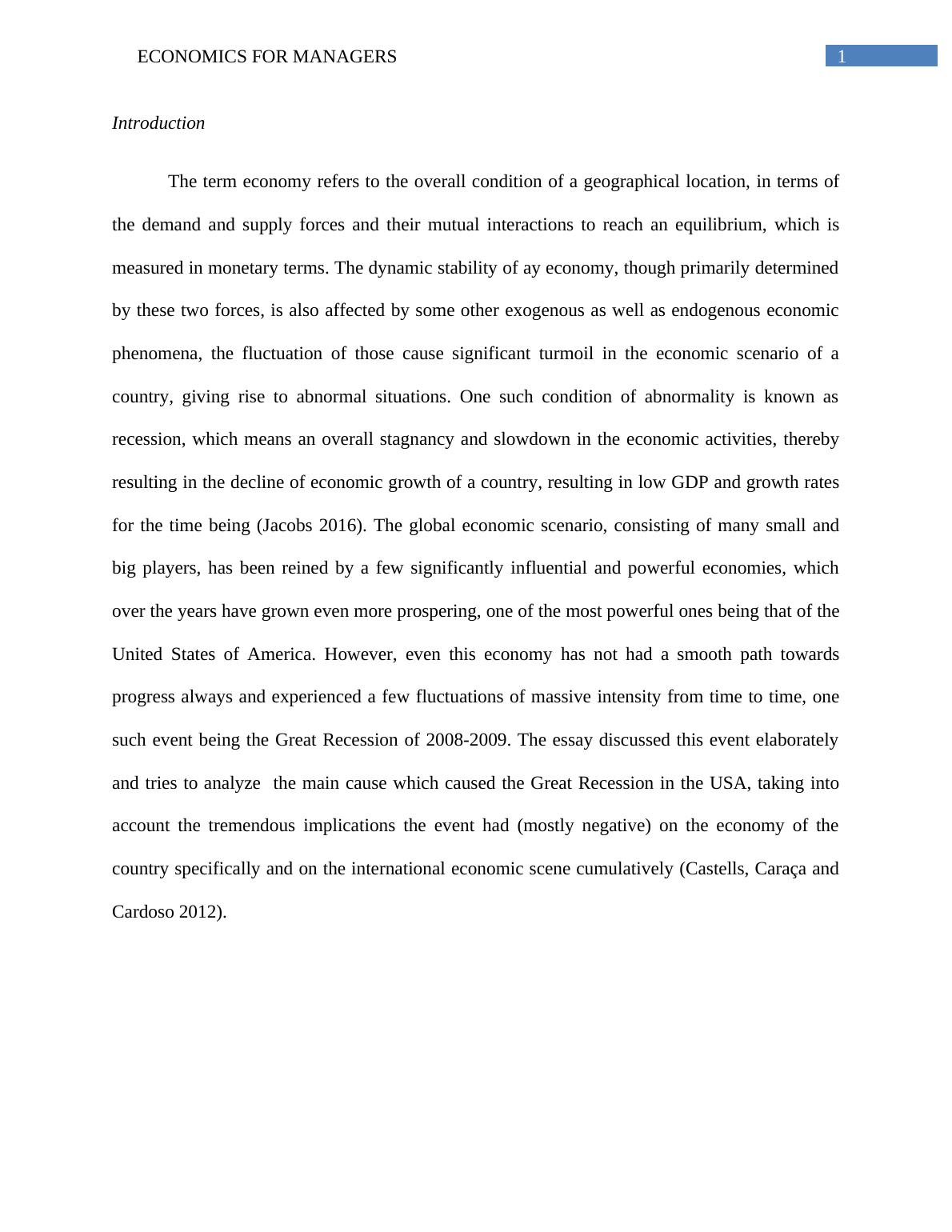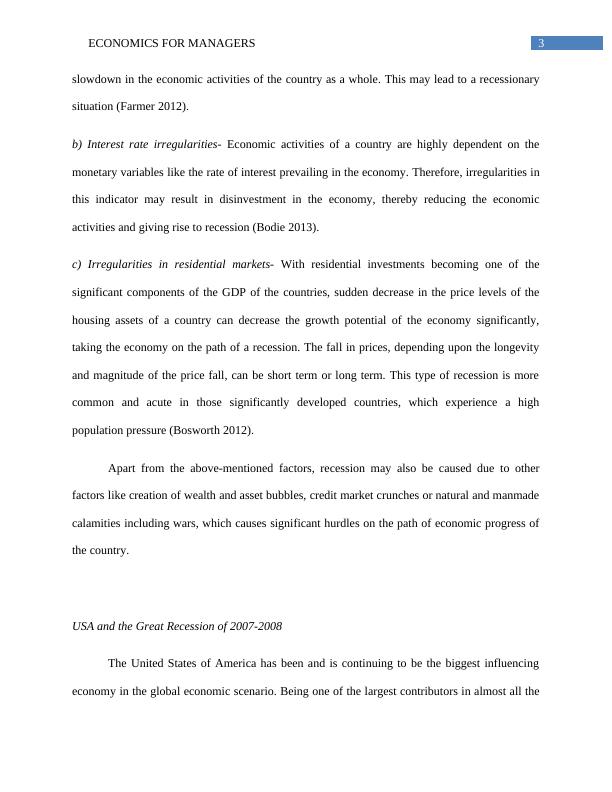Economics for Manager | Assignment
Added on 2019-10-31
13 Pages2985 Words178 Views
Running head: ECONOMICS FOR MANAGERS Economics for ManagersName of the StudentName of the UniversityAuthor Note

1ECONOMICS FOR MANAGERS Introduction The term economy refers to the overall condition of a geographical location, in terms ofthe demand and supply forces and their mutual interactions to reach an equilibrium, which ismeasured in monetary terms. The dynamic stability of ay economy, though primarily determinedby these two forces, is also affected by some other exogenous as well as endogenous economicphenomena, the fluctuation of those cause significant turmoil in the economic scenario of acountry, giving rise to abnormal situations. One such condition of abnormality is known asrecession, which means an overall stagnancy and slowdown in the economic activities, therebyresulting in the decline of economic growth of a country, resulting in low GDP and growth ratesfor the time being (Jacobs 2016). The global economic scenario, consisting of many small andbig players, has been reined by a few significantly influential and powerful economies, whichover the years have grown even more prospering, one of the most powerful ones being that of theUnited States of America. However, even this economy has not had a smooth path towardsprogress always and experienced a few fluctuations of massive intensity from time to time, onesuch event being the Great Recession of 2008-2009. The essay discussed this event elaboratelyand tries to analyze the main cause which caused the Great Recession in the USA, taking intoaccount the tremendous implications the event had (mostly negative) on the economy of thecountry specifically and on the international economic scene cumulatively (Castells, Caraça andCardoso 2012).

2ECONOMICS FOR MANAGERS Recession Recession, in the broad sense of the term in economics, refers to the stagnancy and aslowdown in general of an economy, with the overall economic activities (productive, industrialas well as trading) reducing significantly. Much of the recessionary situations arise due to theoverall loss in the confidence upon the economy, from both the consumer side and the producerand investor side. With the loss of the overall confidence of the residents from the economy andits future prospects, the supply levels and productivity declines, which in its turn, leads tolowering of wages and creation of jobs, thereby increasing the unemployment burden (Stock andWatson 2012). The direct impact of this recessionary pressure falls on the standard of living ofthe residents of the economy as a whole. The nature of recession being cyclical by default, thephenomenon often creates a viscous cycle of burden for the economy, thereby taking theconcerned economy on a spiral path of sufferings and poverty burden. The impacts of a recessioncan be seen on the declining growth rates of GDP and GDP per capita of the country at that pointof time (Auerbach and Gorodnichenko 2012). Causes of recession Among the various factors, which give rise to a recessionary situation in an economy,there are several key factors, which mostly commonly leads to recession in any economy. Fewsuch factors are explained below: a) Stock market turmoil- Stock market being the backbone of any developed and developingeconomy in the contemporary period, a sudden crash in the share values of the companies andloss of investors’ confidence on the profitability of those companies can lead to an overall

3ECONOMICS FOR MANAGERS slowdown in the economic activities of the country as a whole. This may lead to a recessionarysituation (Farmer 2012). b) Interest rate irregularities- Economic activities of a country are highly dependent on themonetary variables like the rate of interest prevailing in the economy. Therefore, irregularities inthis indicator may result in disinvestment in the economy, thereby reducing the economicactivities and giving rise to recession (Bodie 2013). c) Irregularities in residential markets- With residential investments becoming one of thesignificant components of the GDP of the countries, sudden decrease in the price levels of thehousing assets of a country can decrease the growth potential of the economy significantly,taking the economy on the path of a recession. The fall in prices, depending upon the longevityand magnitude of the price fall, can be short term or long term. This type of recession is morecommon and acute in those significantly developed countries, which experience a highpopulation pressure (Bosworth 2012). Apart from the above-mentioned factors, recession may also be caused due to otherfactors like creation of wealth and asset bubbles, credit market crunches or natural and manmadecalamities including wars, which causes significant hurdles on the path of economic progress ofthe country. USA and the Great Recession of 2007-2008 The United States of America has been and is continuing to be the biggest influencingeconomy in the global economic scenario. Being one of the largest contributors in almost all the

End of preview
Want to access all the pages? Upload your documents or become a member.
Related Documents
Economics for Managers : Assignmentlg...
|12
|2843
|303
Economics Assignment on Great Recessionlg...
|16
|3233
|183
Relationship between Real GDP, Inflation, Unemployment, Business Cycle and Net Exports in Australialg...
|7
|1765
|354
Macroeconomic Analysis of Australia: Real GDP, Inflation, Unemployment, Business Cycle, Net Exports and Exchange Rateslg...
|12
|4372
|275
Australia Economic Progress Report | Studylg...
|5
|1364
|16
ECON394 The Japanese Economylg...
|14
|2963
|41
